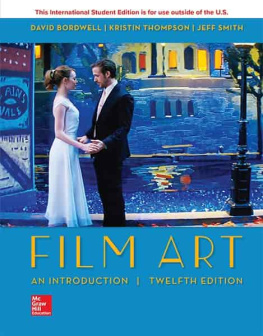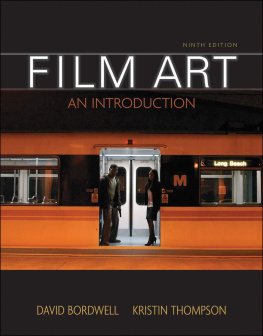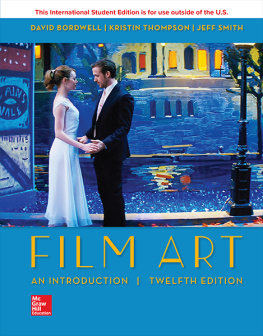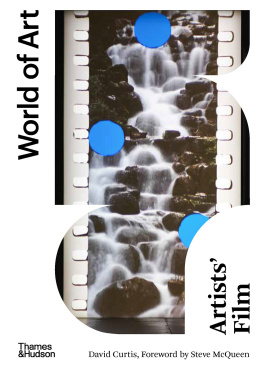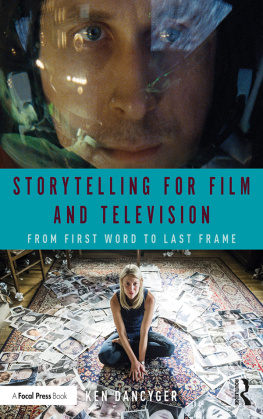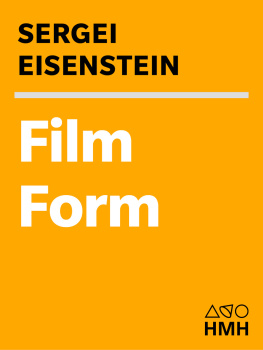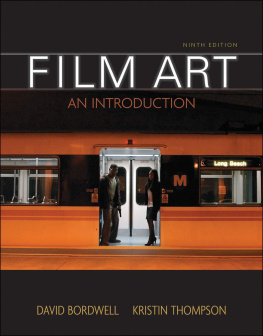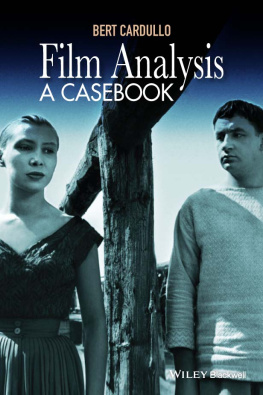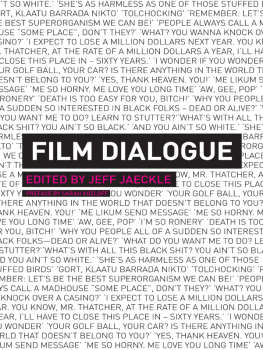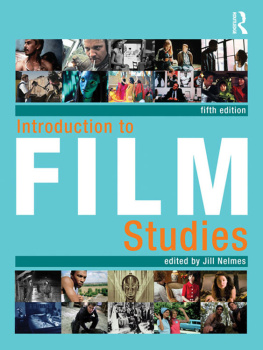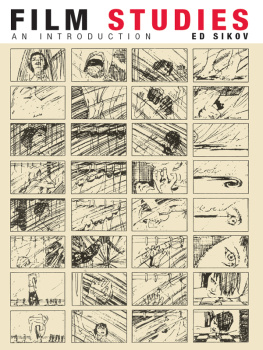
Page iii
TWELFTH EDITION FILM ART AN INTRODUCTION David Bordwell University of WisconsinMadison Kristin Thompson University of WisconsinMadison Jeff Smith University of WisconsinMadison
Page iv
FILM ART
Published by McGraw-Hill Education, 2 Penn Plaza, New York, NY 10121. Copyright 2020 by McGraw-Hill Education. All rights reserved. Printed in the United States of America. No part of this publication may be reproduced or distributed in any form or by any means, or stored in a database or retrieval system, without the prior written consent of McGraw-Hill Education, including, but not limited to, in any network or other electronic storage or transmission, or broadcast for distance learning.
Some ancillaries, including electronic and print components, may not be available to customers outside the United States.
This book is printed on acid-free paper.
1 2 3 4 5 6 7 8 9 LWI 21 20 19
ISBN 978-1-260-56566-9
MHID 1-260-56566-1
Cover Image: Scene from La La Land courtesy of Summit Entertainment LLC. Photo also appears with permission from director Damien Chazelle, and actors Emma Stone and Ryan Gosling.
All credits appearing on page or at the end of the book are considered to be an extension of the copyright page.
The Internet addresses listed in the text were accurate at the time of publication. The inclusion of a website does not indicate an endorsement by the authors or McGraw-Hill Education, and McGraw-Hill Education does not guarantee the accuracy of the information presented at these sites.
mheducation.com/highered
Page v
ABOUT THE AUTHORS
David Bordwell is Jacques Ledoux Emeritus Professor of Film Studies in the Department of Communication Arts at the University of WisconsinMadison. He also holds a Hilldale Professorship in the Humanities. He completed a masters degree and a doctorate in film at the University of Iowa. His books include The Films of Carl-Theodor Dreyer (University of California Press, 1981), Narration in the Fiction Film (University of Wisconsin Press, 1985), Ozu and the Poetics of Cinema (Princeton University Press, 1988), Making Meaning: Inference and Rhetoric in the Interpretation of Cinema (Harvard University Press, 1989), The Cinema of Eisenstein (Harvard University Press, 1993), On the History of Film Style (Harvard University Press, 1997), Planet Hong Kong: Popular Cinema and the Art of Entertainment (Harvard University Press, 2000; 2nd ed., Irvington Way Institute Press, 2011), Figures Traced in Light: On Cinematic Staging (University of California Press, 2005). The Way Hollywood Tells It: Story and Style in Modern Movies (University of California Press, 2006), Poetics of Cinema (Routledge, 2007), Pandoras Digital Box: Films, Files, and the Future of Movies (Irvington Way Institute Press, 2012), The Rhapsodes: How 1940s Critics Changed American Film Culture (University of Chicago Press, 2016), and Reinventing Hollywood: How 1940s Filmmakers Changed Movie Storytelling (University of Chicago Press, 2017).
Kristin Thompson is an Honorary Fellow at the University of WisconsinMadison. She holds a masters degree in film from the University of Iowa and a doctorate in film from the University of WisconsinMadison. She has published Eisensteins Ivan the Terrible: A Neoformalist Analysis (Princeton University Press, 1981), Exporting Entertainment: America in the World Film Market 19071934 (British Film Institute, 1985), Breaking the Glass Armor: Neoformalist Film Analysis (Princeton University Press, 1988), Wooster Proposes, Jeeves Disposes, or, Le Mot Juste (James H. Heineman, 1992), Storytelling in the New Hollywood: Understanding Classical Narrative Technique (Harvard University Press, 1999), Storytelling in Film and Television (Harvard University Press, 2003), Herr Lubitsch Goes to Hollywood: German and American Film After World War I (Amsterdam University Press, 2005), and The Frodo Franchise: The Lord of the Rings and Modern Hollywood (University of California Press, 2007). She is also an amateur Egyptologist and since 2001 a member of an expedition to Egypt.
Bordwell and Thompson have previously collaborated on Film History: An Introduction (McGraw-Hill, 4th ed., 2018), Minding Movies: Observations on the Art, Craft, and Business of Filmmaking (University of Chicago Press, 2011), Christopher Nolan: A Labyrinth of Linkages (Irvington Way Institute Press, 2013), and, with Janet Staiger, on The Classical Hollywood Cinema: Film Style and Mode of Production to 1960 (Columbia University Press, 1985). For their blog and other online information, visit www.davidbordwell.net.
Jeff Smith is a professor in the Communication Arts Department at the University of WisconsinMadison. He received his masters degree and doctorate in film at that same institution. He is the author of two books: The Sounds of Commerce: Marketing Popular Film Music (Columbia University Press, 1998) and Film Criticism, the Cold War, and the Blacklist: Reading the Hollywood Reds (University of California Press, 2014).
All three authors regularly contribute video introductions to films on the Criterion Channel of FilmStruck.
To our parents,
Marjorie and Jay Bordwell
Jean and Roger Thompson
Virginia and Rod Smith
and Anne and John Ceranski
Page vi
PREFACE
Film Art helps students master the skills of film appreciation by teaching them to analyze and appreciate classic and contemporary films. Enhanced by McGraw-Hill Educations Connect and SmartBook, Film Art delivers a learning and teaching experience tailored to the needs of each institution, instructor, and student.
DIGITAL SUITE FOR FILM ART
For nearly a generation, Film Art has helped students become informed viewers of classic and contemporary films by explaining key vocabulary and concepts of film forms, techniques, and history. With McGraw-Hill Educations Connect, students are better equipped to understand and retain these basic concepts. McGraw-Hill Connect for Film Art is a highly reliable, easy-to-use homework and learning management solution that utilizes award-winning adaptive tools to improve student results. Connects assignments help students contextualize what theyve learned through application, so they can better understand the material and think critically about it.
SmartBook is included in Connect for Film Art and provides an interactive reading experience that helps students study more efficiently through adaptive highlighting and review. As a student uses SmartBook, it creates a personalized learning path that highlights the most important concepts the student needs to grasp at that moment in time.
New to the twelfth edition of Connect for Film Art is the Connect eBook, which makes it easy for students to access their study material on smartphones and tablets. They can study on the go and dont need Internet access to use the eBook with full functionality.
CRITERION COLLECTION IN CONNECT
Studying film isnt just about learning the facts; its also about the skills of watching and listening closely. Together with the Criterion Collection, weve developed a series of tutorials and Film Analysis Assignments to introduce students to the world of film and challenge them to develop the critical-analysis skills necessary to become informed viewers.
The authors have partnered with the Criterion Collection to create brief video tutorials, available exclusively in Connect. The tutorials use film clips to clarify and reinforce key concepts and model the critical skills necessary to become informed viewers. They can be shown in class or assigned for students to view outside class, with brief optional follow-up quizzes. Exclusive to Connect for Film Art, these videos can be accessed and used in a few different ways:
Next page
